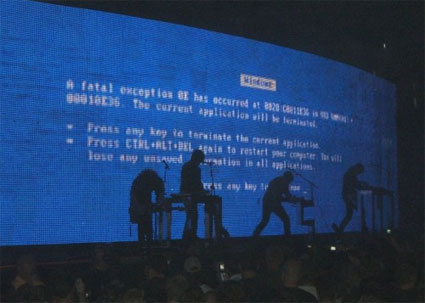
Don’t you hate when you see something like this happen. You know someone, somewhere had a really bad night.
You can imagine the band’s management yelling into their cell phone as techs scramble to get systems rebooted or rolled over to backup while simultaneously updating their resume in their heads. There are hundreds of hands reaching for hundreds of phones to send pictures to roommates who decided to bail and stay back at the bar.
How many people in the audience are shouting, “Did you try control, alt, delete?!” Imagine the quiet thrill of the the elite handful who could actually knew what went wrong based on the error message. Disappointment soon followed for the elite of the elite who actually had dates as it slowly dawned on them that demonstrating this particular level of alpha nerdiness wasn’t getting them any action that night.
As much fun as it was to imagine all that, it’s not even close to what’s really happening. The big screen blue screen of death (BSoD) shown here was intentional. It’s actually part of the act and not a real OS error message. Turns out Trent Reznor of Nine Inch Nails is a serious Mac fanboy.
Does this picture bring back bad memories? Have you ever been unfortunate enough to see a BSoD on the screen you were supposed to be projecting something rather important on? Whether you’re the AV tech or a presenter showing your own slides, it can be a unforgettably unpleasant moment. Changes to Windows have (supposedly) pretty much eliminated the BSoD. I don’t know if that’s true but I’ll admit can’t remember the last time I saw one.
*Â Â *Â Â *
Sometimes I think we take for granted how much easier it is to recover from badly timed computer failures now than it used to be.
Remember what it was like during the time of transition as 35mm slides were fading away? We had this great, new technology that saved us all a huge amount of time, money and effort, but sometimes it seemed like this great, new technology wasn’t always so great. It often failed, often in ways we never experienced before. To make matters worse, we didn’t yet have the tools necessary to easily recover from these failures.
For example, there were no USB flash drives. How many times would our bacon have been saved if there had been a storage media with enough capacity to easily transports multiple presentation files. One that also worked seamlessly and immediately with any computer you connected it to.
Remember floppy disks? Remember only having 1.44 MB of space to work with? How about ZIP drives? More storage space, but they needed to have software installed before you could use them. They also weren’t completely reliable (I still find myself waking up in a cold sweat from a vivid “Click of Death” flashback nightmare).
It was also very unlikely that the ballroom where you were presenting had Wifi and many hotels didn’t have any kind of internet capabilities at all.
So not only was it more difficult to move content between computers, this was also before it was common for just about everyone in an organization to have a laptop with them at the meeting venue. If you got the BSoD, you couldn’t just grab someone’s machine and throw the presentation on it, or run it right from a USB drive, or download it from the corporate servers, etc.
Remember, and be grateful, as you’re planning for your next life-or-death presentation: you have tremendous advantages that weren’t available just a few years ago.
Just make sure you take advantage of them.